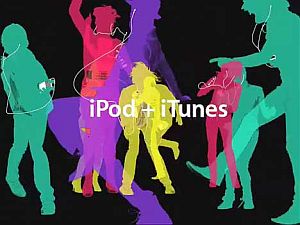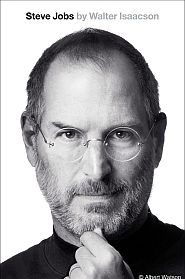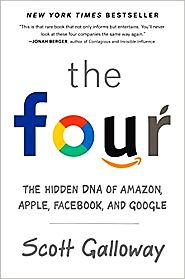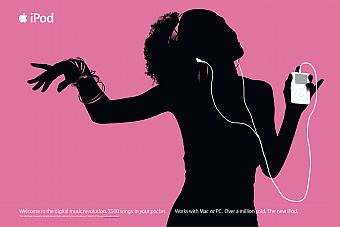
Apple "silhouette"-style advertising for the iPod digital music player, circa 2003-2005.
Initiated first with the iPod digital music player, the ads – which soon appeared globally in print, on TV, the web, and in various outdoor venues – proved to be one of the most effective marketing campaigns of the early 21st century. The dancing iPod silhouettes permeated the culture of their day and left their mark on the advertising industry as well.
The silhouette ads were particularly notable for the evocative effect they had on culture, fashion, and “hipness”– reaching Apple customers and well beyond. The distinctive marketing art used in these ads also helped Apple to sell tens of millions of iPods and also billions of songs through Apple’s iTunes music store. And this advertising, in some ways, helped Apple move its business to another level, sending it in into the superstar stratosphere of the world’s most elite and profitable companies.
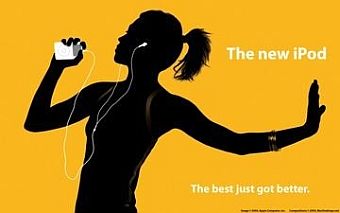
Another silhouette ad from Apple, this one touting "The new iPod -- The best just got better."
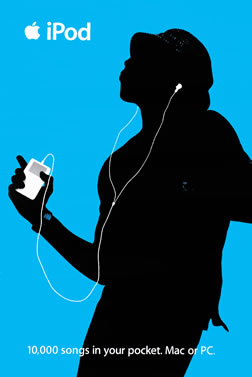
An iPod silhouette ad with the tagline: “10,000 songs in your pocket. Mac or PC.”
The Apple silhouettes danced their way across the American cultural landscape and beyond, having a “pied piper” effect on many who saw them, sending legions straight into Apple stores and Apple websites. By 2007 Apple dropped the word “computer” from its official corporate moniker, thereafter known simply as Apple, Inc.
During the decade of the 2000s, Apple was able to build out its business in a new way, not only with the iPod and iTunes, but by the end of the decade, also with the iPhone and the iPad, rising upon the marketing success of the iPod. As for the innovative advertising, Apple didn’t automatically hit upon the silhouettes campaign at the iPod’s creation, but eventually came to it after a few years into its music marketing. That story – which offers both a compelling visual/cultural record and a very successful marketing tale – continues below.
 Music in your pocket: 1960s Lincoln 6 Transistor Radio. |
 Sony Sports Walkman of 1990s was used by joggers. |
Portable Music
Portable music in modern times dates to the 1950s and the early hand-held and pocket-size transistor radios. First invented in 1954, billions of transistor radios were produced and sold through the 1960s and 1970s. They were the first devices to allow people on the move to listen to music anywhere they went. Then came the early cassette tape players in the mid-1960s. The Sony Walkman compact cassette player soon became the ascendant model and very popular, dominating the market through the 1980s. The Walkman, in fact, then defined the portable music market, selling 300 million units in two decades, as cassette sales overtook those of vinyl LPs recordings. With the compact disc came portable CD players, such as the Sony Discman and others. By the mid-1990s, however, a new form of digital music, made possible by MP3 files, began to substantially change the underlying nature of the music business. Internet file sharing and peer-to-peer (P2P) networks for digital music files – regarded as an illegal practice – soon followed. In June 1999 a file-sharing website named Napster emerged to become a dominant music power, and along with others such as Kazaa, facilitated illegal digital music sharing, upending the global music industry.
The Apple Computer Co. around this time was just getting up off the mat after some hard times. Former Apple founder, Steve Jobs, who had been fired from his own company after an inventive first run there during 1976-1985, had been re-hired at Apple in 1997. Once he returned to the helm at Apple, Jobs soon revived the company’s flagging computer business and charted a new course for the company.Steve Jobs envisioned a music player and a music store as two satellite parts in a multi-faceted “digital hub” strategy built around the Macintosh desktop computer. He envisioned a “digital hub” strategy with Apple desktop computers at the center and other peripheral devices — MP3 players, digital cameras, camcorders – plugging into and using the computer as editor, manager, and storage central, whether for photos, movies, or music. Jobs instructed Apple programmers to come up with software for all of these activities. The iPod music player grew out of this strategy, as did a plan for selling the music itself. By January 2001, Jobs and Apple launched an early version of something they called iTunes for the Macintosh computer, a program that allowed Mac users to organize digital music files on their computers, convert audio CDs into compressed digital files, and play internet radio music. iTunes would become a very successful music-selling business and a key component in the iPod’s success – but not at first. There’s a bit more history before this occurs.
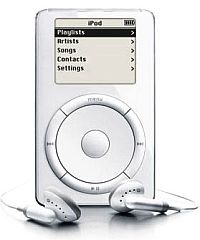
First generation iPod music player, 2001.
By early 2000, Jobs and Apple had also surveyed the field of existing MP3 music players and found them lacking. Most fell into one of two categories: “big and clunky” or “small and useless.” They were also not very user friendly. So Jobs asked one of his top hardware guys, Jon Rubinstein, to see if Apple could come up with something better. Rubinstein picked an outside engineer and music lover named Tony Fadell to be team leader, heading up a group of about 30 people. Fadell, who had shopped his own idea for improved music players to other companies with no takers, was given the task of creating a digital music player that had to be ready by fall for the 2001 Christmas season. The desired music player, Fadell was told, would need to have very fast computer connectivity to enable quick uploading of songs, and work seamlessly with Apple’s new iTunes software. This music player would also need to be easy to use and be cleanly and attractively designed. In building their first music player, Fadell and Apple engineers had the benefit of some “on-the-shelf” and Apple-acquired technology – a 1.8-inch hard drive from Toshiba, a battery from Sony, and microchips from Texas Instruments. Still, amazingly, in about six months’ time, the first iPod digital music player was produced. A freelance writer named Vinnie Chieco who was helping Apple on the project and had seen a prototype of the all-white music player, was reminded of a scene in the Stanley Kubrik movie. 2001:A Space Odyssey and the phrase, “Open the pod bay door, Hal!” He suggested they call the music player a “Pod.” Jobs, who had already named things iMac and iTunes, added the “i” to Pod, and so it was.
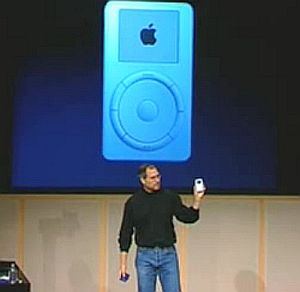
Steve Jobs on stage, October 23, 2001, introducing the first iPod digital music player.
Still, this was not the most propitious of times to launch a new consumer gadget, as the country was still reeling from the 9/11 terrorist attacks and the economy was in recession. Nonetheless, Jobs and Apple pushed forward.
“Music is a part of everyone’s life,” he explained to his audience of journalists, Apple engineers, and technology enthusiasts. “And because it’s a part of everyone’s life, it’s a very large target market all around the world. It knows no boundaries.”
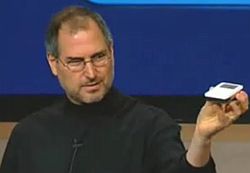
Steve Jobs showing off the thinness of the new iPod music player, October 2001.
Jobs then walked his audience through the virtues of the new device with the aide of a slide show on a giant screen behind him and why Apple was now targeting the music business. Flashed on the screen during his talk were some bulky portable CD players.
The iPod, by comparison, was small and sleek, weighing about 6.5 ounces. Roughly equivalent to the size of a deck of playing cards or a pack of cigarettes, the iPod would fit easily into a shirt pocket. It was similar, in size, to an old 1950s transistor radio, but thinner and more elegantly designed. Jobs called the iPod a “breakthrough digital device.” It had a 5 GB hard drive – enough capacity to put “1,000 songs in your pocket.” Critics, however, were not initially bowled over. Some blanched at the high price. Others suggested it as a ploy to sell more Mac computers. Business Week said it wasn’t a good business strategy.
The iPod, however, would prove to be in a category all its own. It offered an innovative click-wheel scrolling device to fine songs quickly, had impressive battery life, lots of storage capacity, and a very fast download capability thanks to something called FireWire. The Apple iPod, Jobs explained, could download an entire CD in under 10 seconds and 1,000 songs in less than 10 minutes. “You can put your whole music library into your pocket,” he said at the time – a phrase that would become one of the new music player’s selling points.
The advertising for the first iPod, however, wasn’t anything special. In fact, a single TV commercial featured a geeky-looking guy in his apartment dancing and moon-walking to an techno-instrumental song “Take California” by the band the Propellerheads. The message in the ad was simple: plug this thing into your ears and you’ll soon be enjoying your favorite music. The ad showed the geeky guy easily downloading music from his Mac computer into his iPod, then putting the thing into his shirt pocket as he exited his apartment wired for sound on-the-move. Message: you can take all your music with you. This ad signed off with Apple’s earlier “Think Different” advertising slogan. Jobs had favored a traditional type ad to introduce the new product, to show the download step and the iPod’s ease of use, and also its portability. But this ad, while adequate for the moment, may have been confusing to some, showing it working with a Macintosh computer. Still, after a few months on the market, by December 31, 2001, Apple had sold 125,000 iPods. But this was just the beginning.
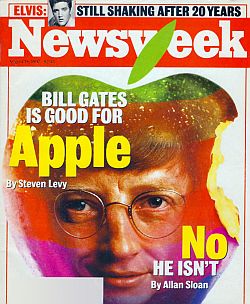
Bill Gates had helped Steve Jobs in 1997, but Jobs was reluctant at first to make iPods and iTunes compatible with Windows PCs.
Early on in the iPod story, Jobs and Apple came to realization that what they had might be a lot bigger than just something for those who used Macintosh computers. Mac users then constituted only a small part of the personal computer universe. The overwhelming majority of the world’s personal computers then ran on Microsoft’s Windows software. However, Steve Jobs and Microsoft’s Bill Gates, were not exactly bosom buddies. Their companies had been rivals, but in 1997, Gates and Microsoft made a key $150 million investment in Apple at a crucial time after Jobs had resumed control. Still, in this new realm of music-related business, Jobs was generally resistant to the idea of Windows compatibility for iTunes, as he had preferred an “Apple walled garden” of internal Apple-only technologies. However, he eventually came around to the business imperative of the giant Windows market. On July 17th, 2002, Jobs introduced second generation update of the iPod at MacWorld Expo in New York City. It was now compatible with Windows computers, first through Musicmatch Jukebox – a temporary solution until Apple could write its own “iTunes-for-Windows” software (that would come in October 2003). Jobs would later acknowledge that Apple “decided that the iPod was too big to keep in the Mac universe, which turned out to be the right decision.” By October 2002, iPods were being sold in major retail outlets such as Best Buy, Dell, and Target. And in December 2002, the iPod also had its first link with celebrity, as Apple issued limited-edition iPods featuring engraved signatures of pop music’s Madonna, skateboard star Tony Hawk, and singer-songwriter Beck. By the end of 2002, Apple had sold 600,000 iPods.

Oprah gave away 350 iPod music players to her TV audience on a May 2003 show.
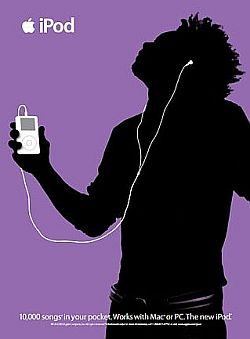
The tagline at bottom reads: “10,000 songs in your pocket. Works with Mac or PC. The new iPod.”
The Silhouettes
The silhouettes advertising campaign for the iPod really didn’t take hold until the fall of 2003. It was developed and coordinated by Apple’s ad agency, TBWA/Chiat/Day. In the late 1960s, Lee Chiat and Guy Day formed the Chiat/Day agency in California, a firm that would later merge with TBWA in 1995.
Apple began working with Chiat/Day in 1981, and the agency quickly helped Apple grow its early computer business with some famous campaigns – the 1984 “Big Brother” Superbowl TV ad, the “Think Different” campaign in 1998, and also later advertising for the iMac computer and the “Get A Mac” campaign.
Lee Clow, Chiat/Day’s director, became a close friend to Steve Jobs, with Jobs giving Clow and his agency the artistic freedom to design Apple campaigns. But Jobs himself often had his own ideas about advertising, and like all things at Apple, could be quite forceful in pushing his views and shaping Apple campaigns. In the case of the silhouettes campaign, however, Lee Clow’s agency held its own.

iPod silhouette ad with yellow background.
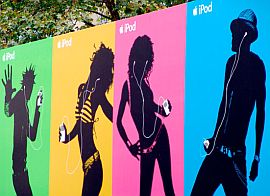
Row of outdoor iPod silhouette ad posters.
“So I moved $75 million of advertising money to the iPod, even though the category didn’t justify one hundredth of that,” he would later tell Walter Isaacson. “That meant that we completely dominated the [advertising] market for music players. We outspent everybody by a factor of about a hundred.”

September 2003: iPod billboard in Los Angeles, CA.
In early September 2003, TBWA/Chiat/ Day, launched the iPod “silhouette” ad campaign featuring anonymous, black-silhouetted dancing figures holding white iPods with their free flowing connecting ear-bud wires, also white. The figures were cast against brightly colored backgrounds of tropical-like colors – lime green, yellow, fuchsia, bright blue, and pink. The first ads were placed on outdoor billboards in Los Angels, California. By September 15th the ads were also running in newspapers. By October, iPod silhouette ads were appearing in music and sports magazines, and a number of others, including Entertainment Weekly, MacWorld, Wired, and Newsweek. The silhouette print ads used taglines such as “Welcome To The Digital Music Revolution” and “10,000 Songs in Your Pocket.” The campaign also included posters in public places, building broadsides, and “wrap advertising” used on buses, trains and subway cars.
The print ads were followed by TV spots that put the same silhouetted figures in motion, each backed with very energetic and danceable rock, pop, and hip hop music. The first television spot featured silhouetted dancers and performers wearing iPods while moving to the music of a group named the Black Eyed Peas. Their song “Hey, Mama,” was used in the TV ad, shown at right.
The Black Eyed Peas — a hip hop/rap/pop group from Los Angeles — were not well known at the time, and the iPod TV spot helped improve their notice.
The iPod silhouette TV spots at this time also included the tagline, “Now for Windows” or “iPod+ iTunes.” Two other TV ads followed using different groups and their songs – “Are You Gonna Be My Girl,” by Australian rock band Jet (shown below), and another featuring “Rock Star” by N.E.R.D.
The silhouette ads soon became ubiquitous and were beginning their rise to iconic status. Helping to do that was the sharp contrasting imagery of the white iPod unit, white earbuds, and the connecting, free-flowing white wires. This “whiteness” turned out to be a marketing masterstroke, focusing attention on the product in a unique way, while also becoming an iconic part of the image.
In production, however, the white earbuds and white wires were a happy accident, and were only white and not black because the iPod itself was white. In the ads, it was the white color that detailed and set off the gadget — the thing to be coveted and acquired. One observer would later say that Apple had “stolen” the color white – or at least hi-jacked it to good commercial advantage. In 2003, Apple also ran versions of the silhouette ads on the web at music sites and elsewhere, aimed in part at those illegally downloading music, trying to coax them over to iTunes, using taglines such as “Download Music,” and “Join the Digital Music Revolution.”
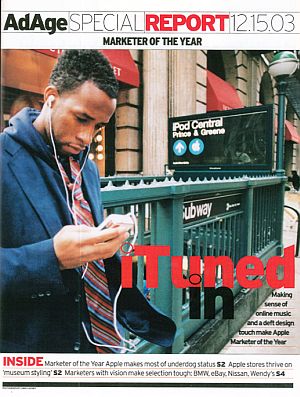
Cover of an Ad Age magazine special report in December 2003 on Apple becoming “Marketer of the Year” for its iPod and iTunes ad campaign.
In October 2003, when Steve Jobs announced the availability of Apple’s iTunes-for-Windows software and also gave a screening of the first silhouette TV ads, he was joined in his presentation with on-screen visits from music artists, including Mick Jagger of the Rolling Stones, Bono of U2, and hip-hop’s Dr. Dre. U2’s Bono called the iPod and iTunes “a very cool thing for musicians and music.” After three months of silhouettes advertising, iPod sales were up by 50 percent over that of the previous quarter. In the U.S. by then, the iPod also had the biggest market share of all MP3 players.
Apple, meanwhile, was doing a full-court press, pushing for a media “buzz effect” on its iPod + iTunes music and marketing. By December 2003, according to one account, the Apple publicity machine has secured 6,000 iPod and iTunes stories in major publications worldwide. Advertising Age magazine would name Apple “marketer of the year” based largely on the success of its iPod advertising campaign. The cover of a special Ad Age report featured Apple (shown above), also mentinong a story on the ‘museum styling” of Apple’s brick-and-motor retail stores, which were also coming on around that time. By the end of 2003 Apple had sold over two million iPods, and iTunes more than 50 million songs.
In 2004, between January and August, Apple reportedly spent $49.6 million on the iPod “silhouette” campaign, with ads and posters out everywhere. Duke University that fall, 2004, began handing out iPods to all incoming freshmen. One TV spot released in 2005, titled “Wild Postings” (shown at left), used the silhouette style in part and was cast using street scenes in an urban setting. The song in the ad was “Ride” by The Vines. The ad’s “story” involved a man leaving a building and walking along an urban street, passing a wall of iPod silhouette posters along the way. The iPod silhouette ads were by this time familiar to many. In the TV ad, as the young man passes the posters with his iPod playing, the poster figures come to life and dance inside their frames. But when the young man hits the stop button on his iPod and looks around momentarily, the figures freeze, coming to life once again as he hits “play” and resumes his walk.
The Urban Ad
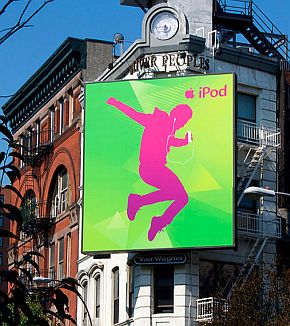 iPod silhouette billboard ad, New York City. |
 Aug 2005: Large posters of iPod dancers adorn buildings above shoppers in Hong Kong. |
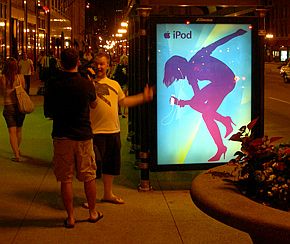 Illuminated iPod poster ad at Chicago bus stop kiosk, June 2008. |
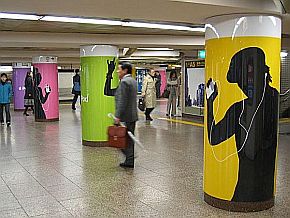 2004: iPod ads on underground subway columns. |
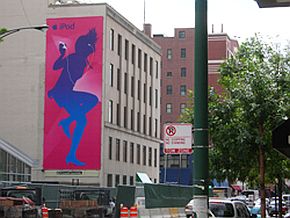 2008: iPod building broadside, Chicago, Illinois. |
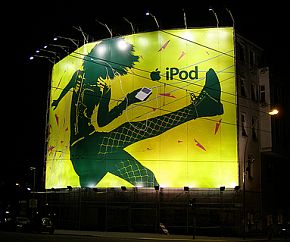 2007: iPod billboard ad at night, Berlin, Germany. |
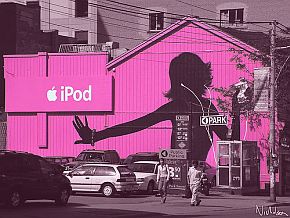 July 2006: iPod building broadside, parking lot, Toronto, Canada. |
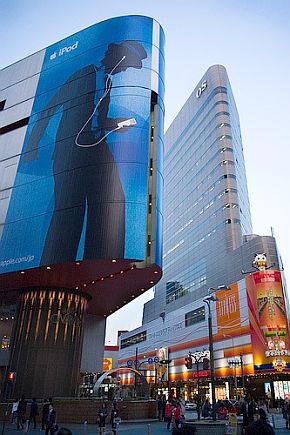 2004: Giant iPod silhouette ad on the side of a building, Osaka, Japan. |
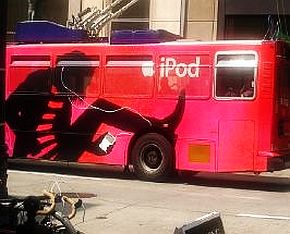 “Bus wrap” - iPod silhouette outdoor advertising. |
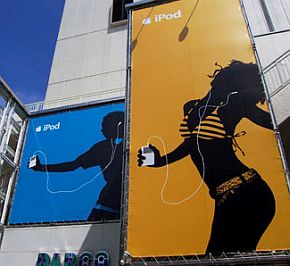 2003-2004: iPod outdoor advertising. |
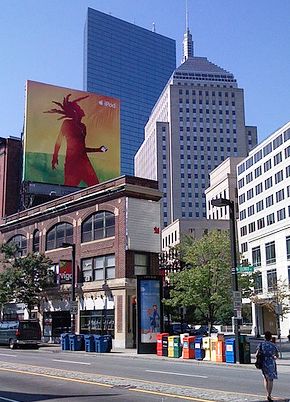 2007: Apple iPod silhouette outdoor ad, Boston, MA. |
 Apple iPod silhouette advertising on Japan Railway cars. |
Urban settings, in fact, became a particularly important part of the iPod silhouette campaign, as billboard ads, bus kiosk posters, building broadsides, bus and train “wraps,” hanging banners, poster walls, and other forms of outdoor and “guerrilla” advertising appeared throughout major cities. Outdoor advertising has gone on for decades, of course, yet Apple’s silhouette campaign – featured in major cities including New York, Chicago, Los Angeles, Paris, London, Amsterdam, San Francisco, Shanghai Hong Kong, Toronto, Oska, and more – offered something of both a new look and a new intensity. Some cities were simultaneously flooded with iPod billboards, posters and banners outside, while also running print ads and TV commercials in those markets, the message being, “iPod is everywhere.”
iPod ads appeared in giant proportion on entire walls of huge buildings, and also in brightly-lit bus stop kiosks. In the latter case, the sharply-illuminated iPod ads in their vivid tropical colors stood out as beacons in the darkness. They offered a near luminescent quality, and could be seen at some distance, with curious, first-time onlookers no doubt drawn to them.
In some cities, Apple made creative use of big spaces, as in train stations and other commuter locations. In November 2003, one blogger, reporting on the scene at Philadelphia’s busy 30th Street Station of trains and subway system, noted: “There were two of those huge [wall size murals] in the lobby, and on the SEPTA platform they bought every single Viacom billboard. The Amtrak platform was also covered pretty well.” By March 2004, in Paris, iPod ads were used extensively in the St-Lazare train station, where iPod silhouette banners were suspended from the ceiling every few meters. Elsewhere in the station, larger 10 foot-by-30-foot panels were used atop escalator platforms. In Amsterdam, outside the Leidsestraat station, an enormous blue iPod billboard greeted commuters as they came and went at the station.
In Canada, at the McGill subway terminal in Montreal, iPod silhouette ads were practically everywhere, at ticket stands, waiting platforms, and at turnstiles. Stairways leading out of the station have also been converted into colored iPod murals, with the front of each step making up the canvas. In Toronto, building broadsides and buildings and walls adjacent to parking lots were painted with huge iPod silhouette figures. Toronto subway stations and subway cars were also painted with iPod silhouette figures. By one account, the St. George subway station in downtown Toronto in 2004 had been turned into an “Apple dreamland.” Toronto resident Jonathan Ta-Min, who photographed some of the station, noted that iPod ads adorned nearly every object in the station – posts, walls, stairs, and even newspaper recycle bins. “It definitely brought a smile to my face,” said Ta-Min of the iPod advertising display.
In the U.K., iPod ads appeared in Virgin’s music megastores, bus shelters, and throughout the London Underground. By April 2004, in Japan and France, iPod TV spots also appeared, some around the time the time the iPod mini was shipping.
Back in the U.S., iPod ads appeared in subway stations and on buildings in Boston, New York, Chicago, and a number of other cities. One writer at AAPL Investors.net, who had posted photos of various iPod ads in Chicago, observed:
“Chicago is a music town — hot blues, cool jazz, hard rock and many cultural varieties. So walking the town, where just about every street corner has a bus shelter, you are likely to be joined by colorful dancers groovin’ to their favorite tunes…”
“…In ads so iconic they require no copy more than the Apple iPod logo, we get to enjoy the art. Art that makes a bus shelter or bare wall come alive. Art that makes you smile.”
iPod Psych
Apple and TBWA/Chiat/Day were in effect, insinuating Apple technology into the urban tableau as both fashion and must-have “cool” technology. And their silhouette ads – from train stations and bus kiosks to magazine and TV ads – sent that message out perfectly and in some locations, incessantly, imprinting fashion and “coolness” onto the psyches of millions of potential consumers. And this was especially the case for the young.
Dr. Z. John Zhang, professor of marketing at the Univ. of Pennsylvania’s Wharton School, commenting on the fad that iPod had created, said: “All MP3 players do the same thing, but nobody else has the ‘cool’ factor of iPod. It’s a status symbol: You’re young, cool, and vigorous if you have one.”
Others observed that the silhouettes conveyed to people that they could “be” the person in the ad, dancing, moving, singing, etc.,. One analyst at AdWizard, looking at the effectiveness of the silhouettes campaign, summed it up this way:
“In advertising, we’re taught that the target audience is almost as important as the product itself. It’s common practice to show a representative of the target audience. Someone who the target audience can look at and picture themselves as being. The idea is that if the target audience can imagine themselves in the ad, there’s a better chance of them purchasing the product. The downside is that the ad may dissuade potential customers outside the target audience because the product is ‘not for them.’ But what Apple’s ad agency, TBWA/Chiat/Day, did was allow the target audience put itself in their ads. The silhouetted image is literally a blank canvass that anyone can be placed in.”
Michael Shur and Tyler Reed, business students at the University of St. Thomas writing a paper on Apple’s iPod marketing, suggested a kind of Apple/iPod consumer psychology was at work with the silhouette ads, promoting a type of personality and a “way of being” as much as a product to buy:
“…Over time though, the iPod ads begin to formulate a theme which provides insight into Apple’s psychographic profile of a typical consumer. The dancing loner, stylish, lost in her own world, white earbuds tucked safely in, grooving against bursts of vivid color. These ads transmit a definite sense that there is a personality being promoted, a way of being as much as a thing to buy; a renegade, leading the charge, marching to the beat of her own drummer—which by the way [ in video ad form] is mixed to a completely unique soundtrack. Further, the soundtrack on your own iPod will be better than anyone else’s (certainly better than non-iPod users), and besides, whether it is or not, you are in control of your own destiny; no one else is telling you what to do. These ads have the effect of creating desire, awareness, brand loyalty, and oddly, satisfaction.”
Then again, there have been some observers who felt that Apple was creating something a little too self-important. This view was expressed in March 2004 by Seth Stevenson writing in Slate.com, who had also acknowledged and praised the artistic and marketing effectiveness of the silhouette ads. He wrote, nonetheless:
“…My distaste for these ads stems in part from the fact that… the marketing gives me a sneaking sense that the product thinks it’s better than me. More attractive, far more timeless, and frankly more interesting, too. I feel I’m being told that, without this particular merchandise, I will have no tangible presence in the world. And that hurts. I’m a person, dammit, not a featureless shadow-being!…
…the iPod is designed and marketed to draw attention to itself, and I think (I realize I’m in a minority here) I prefer my consumer goods to know their place…”
Still others would observe that the silhouettes advertising campaign was generally quite effective, taking a product that initially started out as “a gadget for geeks,” as Google Sites writer Justin D. Salsburey described it, and making it “one of the most universally desired products on the market…” That was no mean feat, given society’s proclivity for niche markets and personal individualism.
The silhouettes campaign managed, nonetheless, to give the iPod an appeal that transcended age, ethnicity and social class while not exclusively catering to one group at the expense of others. In its later stages, the campaign also used a wide selection of musical genres in its ads – rock, hip hop, jazz, folk, Latin and other styles.
TBWA/Chiat/Day
Apple’s ad agency meanwhile, TBWA/ Chiat/Day, soon began picking up awards for the iPod silhouette campaign. In June 2004, it won $100,000 Grand Prize Kelly Award, given to ad campaigns that demonstrate creativity and effectiveness.
Mike Hughes, president of The Martin Agency in Richmond, Virginia and a Kelly judge, said of the silhouettes campaign: “It demonstrated to people that you don’t have to spend a lot of time talking about [product] features to get people to make a human connection with your product… Also, one of the core values for Apple is design. To reinforce that without ever talking about it, just by art direction, is an incredibly smart and effective device.”
Apple’s engineers and its iPod team, meanwhile, were continually updating and improving the iPod with new versions. In January 2004, the iPod Mini came out, which was smaller that the original iPod but with the same capacity and about the same price. The Mini became popular with joggers and other active people and would further improve the iPod’s market share. The iPod Mini came in five colors, offered 4GB of storage and featured a solid-state, touch-sensitive scroll wheel.
|
“Silhouette History”  1947: “Icarus” by Henri Matisse. 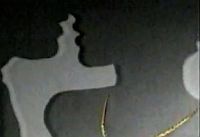 1990s TV ad: “A Diamond is Forever.” The silhouette style, in fact, dates to early portrait techniques that became popular in the mid-18th century, cutting out portraits and profiles of subjects from black card paper. But the term “silhouette” itself wasn’t used much until the early decades of the 19th century.  1970s: “Mudflap Girl.” Apple’s ad agency, TBWA/Chiat/Day, was the lead group on the iPod silhouettes campaign, which also used a variety of subcontractors. The TV ads were created by TBWA/ Chiat/Day art director Susan Alinsangan and Tom Kraemer, the same team that originated the print campaign, which also involved artists Alex Brodie and Stefan Sonnenfeld of Company 3 of Santa Monica, California. Brodie and Sonnenfeld were also involved in the TV ads, as were director Dave Meyers of @radical.media, Chris Davis of Cosmo Street, and Glenn Martin of Nomad, and others. Lee Clow, Duncan Milner, and Eric Grunbaum of TBWA/Chiat/Day were also principals in the campaign. Among other artists who worked on the silhouette campaign was Casey Leveque of Rocket Studio in Santa Monica. |
iPod Breakout
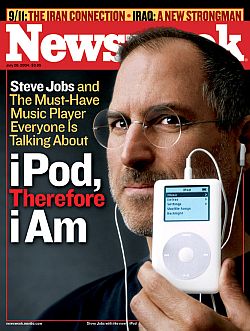
Apple CEO Steve Jobs on the cover of Newsweek magazine, July 26, 2004, as the iPod phenomenon began to take off in a big way.
Steve Jobs noticed something earlier this year in New York City. “I was on Madison,” says Apple’s CEO, “and it was, like, on every block, there was someone with white headphones, and I thought, ‘Oh, my God, it’s starting to happen’.” Jonathan Ive, the company’s design guru, had a similar experience in London: “On the streets and coming out of the tubes, you’d see people fiddling with it.” And Victor Katch, a 59-year-old professor of kinesiology at the University of Michigan, saw it in Ann Arbor. “When you walk across campus, the ratio seems as high as 2 out of 3 people,” he says…
Apple and its super-product, the iPod, had moved to a new level of public notice and economic power, and the silhouettes campaign – which by then had washed over large swaths of urban territory – was part of the reason why. With the release of the iPod 4G in 2004, Apple launched additional silhouette TV commercials. Among these were commercials featuring: Gorillaz’s “Feel Good Inc,” Daft Punk’s “Technologic,” Feature Cast’s “Channel Surfing,” Stereogram’s “Walkie Talkie Man,” and Ozomatli’s “Saturday Night.” iTunes downloads also surpassed 100 million songs in 2004. Yet more was still ahead as the iPod advertising campaign, and Apple’s involvement in the music industry, began to snowball in a new way.

Bono, lead singer and front man for the Irish rock group U2.
Sometime in 2004, Bono, the lead singer for the Irish rock band U2, came to Steve Jobs with something of a novel proposal. At the time, U2 was one of the world’s best known rock bands, but the music business was then changing, and getting new material noticed wasn’t always a sure thing. U2 had been working on a new album and they had one particular song in the album, titled “Vertigo,” a song with a featured segment by U2’s lead guitarist known as “The Edge.” The song, in Bono’s view, was especially good, but it needed exposure to make it a hit.
This was a time, it should be remembered, when MTV — the music television cable channel that helped promote rock music through short videos — had mostly stopped showing promotional rock videos. And YouTube at this point wasn’t yet invented. The avenues for getting new music out were limited. And that’s why Bono came to talk with Steve Jobs at his home in Palo Alto, California. He suggested to Jobs that U2 appear in an iPod TV commercial, and that U2 would do the commercial at no charge to Apple. This was unusual since it normally worked the other way around: i.e., companies would court and pay artists to appear in commercials.
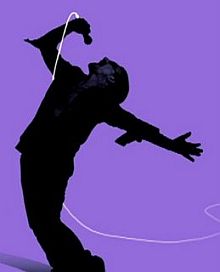
Bono performing in screenshot from U2 iPod ad, 2004.
Still, the proposal Bono made to Jobs didn’t take off immediately, with both sides having their doubts, as the devil is always in the contract details. Jobs, for one, immediately raised the fact that silhouettes advertising campaign used only anonymous forms in its ads. No faces were seen. And this was part of the campaign’s psychology, to put the viewer – and potential “Apple life-style customer” – in that anonymous place. So wouldn’t putting a celebrity in that silhouette space be wrecking one of the key selling pillars of the campaign? Bono suggested the campaign might naturally evolve to “silhouettes of artists.”
A series of meetings and conversations then ensued with Jobs, Bono, other members of the band, business people, and TBWA/Chiat/Day. As the makings of deal went forward, although U2 would not be paid for the ad, Bono and U2 would get a special edition iPod from which they would get royalties. The ad was filmed in London and it showed the band in partial silhouette with cut-aways to iPod dancers in the normal silhouette style. But as the filming proceeded there were second thoughts on both sides, as Bono and band worried they might still get an adverse reaction from their fan base for doing the ad, while Jobs worried about some of the generous economics in the deal and the precedent it might be set for other artists in the future. But with a little help from James Vincent at TBWA/Chiat/Day and Jonny Ive at Apple, the requisite compromises and adjustments were made and the deal held.
In late October 2004, Jobs rented a theater in San Jose for the debut of the U2 TV commercial and unveiling of the U2-edition iPod in its special black-and-red color scheme. Jobs was joined on stage by Bono and The Edge. The final TV spot featured Bono and band performing the song “Vertigo” with Bono and band partially silhouetted against fuchsia, green, yellow, and blue backgrounds. Although shaded in the ad, U2 members Bono, The Edge, Adam Clayton, and Larry Mullen were still partly visible. In cutaway frames focused on the dancers, iPods and silhouetted figures with flowing white wires appeared. In the band segments, Bono’s microphone cord and The Edge’s guitar wires are also white, retaining the series’ artistic trademark. The U2 special-edition iPod, meanwhile, shipped to customers with a $50 coupon toward the download of iTune’s The Complete U2, a collection of 25 years of U2 albums. Within days of the U2 endorsement, Apple’s stock reached a 52-week high of $53.20 per share, adding $2 billion to the company’s overall market value. In the end, Apple spent $20 million worldwide to promote the U2 silhouette spot. But the collaboration seemed to work well for both parties.
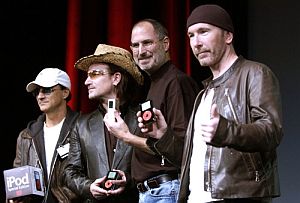
San Jose, 2004: Bono, The Edge and Jimmy Iovine on stage with Steve Jobs receiving U2 special-edition iPods.

U2's Bono in screen shot from iPod TV ad.
Evolving iPod & Ads

2005: iPod Shuffle model did away with the navigation window, featuring all-random play.

2005: Screen shot from iPod Shuffle TV ad featuring the song "Jerk It Out" by The Caesars. Click to view on YouTube.
As the iPod technology continued to evolve and change at Apple, so did the iPod silhouette advertising campaign. Some of the ads began to move away from the solid-color backgrounds and completely silhouetted figures to more mixtures of color schemes and recognizable faces, especially when featuring artists in the ads, as occurred more frequently following the U2 commercial. But for some of the artists used, like rap songster, Eminem, Jobs had to be coached on the music, as he acknowledged rap wasn’t among his favorites. Still, in October 2005, at the release of the fifth-generation iPod during a press event, Jobs showed a new silhouette TV commercial featuring Eminem singing “Lose Yourself.” In this ad, the artist used a white microphone against background colors of fiery yellows and oranges. A dancer in this ad could also be seen with white iPod wires. Near the end of 2005, in November, some new outdoor ads in the yellow-orange silhouette style were prepared by TBWA/Chiat/Day, including one called “Stripey T-Shirt” featuring a break dancer (shown in “Sources” below). By year’s end 2005, Apple had sold more than 20 million iPods for the year, more than five times the number it had sold in 2004.
In January 2006, the big news at the Macworld conference in San Francisco was Steve Jobs unveiling of the iPhone. But silhouette ads carrying the “iPod + iTunes” tagline were still holding forth in outdoor venues, and could be seen across the land. A few TV ads in the silhouette style came out as well. One featured jazz musician, composer and trumpeter Wynton Marsalis and his quartet doing the song “Sparks.” In this ad, like others featuring musical artists, the camera shots alternate between the artists and iPod-attired dancers. The ad is done using classy, shades-of-blue silhouettes. Marsalis’ trumpet is white and his drummer uses white drumsticks, while in other frames traditional silhouette figures dance with their white-wired iPods. The ad was first shown during Steve Jobs’ presentation at the San Francisco Mac World conference in January 2006. Marsalis and his quartet were also live artist guests at the Apple conference in San Jose, October 2005. Prior to that, Marsalis had also visited with Jobs at his home in Palo Alto, and when he visited, he found Jobs absorbed in his technology intent on showing Marsalis the latest iTunes features. “After a while,” Marsalis would later explain of the meeting with Jobs to Walter Isaacson, “I started looking at him and not the computer, because I was so fascinated with his passion.”
As of March 2006, according to Forbes magazine, Apple had spent more than $100 million marketing the iPod to digital media lovers around the globe.
Bob Dylan Ad
Then in mid-2006 came an Apple deal with Bob Dylan; a deal hatched and overseen by Steve Jobs himself who had a special fondness for Dylan’s music. Sometime in 2005 Jobs came up with the idea that iTunes should sell a special digital boxed set of all Dylan’s music – an immense trove of more than 700 songs. Jobs thought iTtunes could sell the set for $199, which brought objection from Dylan’s label, Sony, and its CEO, Andy Lack who felt that price cheapened Dylan’s music, referring to the artist as a “national treasure.” Lack also objected to the power Apple was gaining in establishing price. Still, Jobs persisted, but Lack managed to block him for a time. By 2006, however, Lack was no longer CEO at Sony, and Jobs came back at Dylan with the offer, including an iTunes +iPod TV ad hyping Dylan’s latest album, Modern Times. But Jobs also ran into resistance internally at Apple among some younger staff who wondered whether Dylan was still “cool” enough to do such an ad. Jobs hawked the making of the ad himself, rejecting one version, with Dylan having to re-film a second spot that Jobs approved.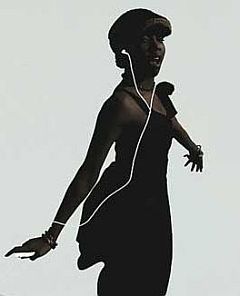
Dancer in the Bob Dylan iPod TV ad holding an iPod while listening & dancing.
With this ad, Apple was apparently able to attract baby boomers and their college-age kids, as Dylan’s Modern Times hit No. 1 on the Billboard charts in its first week, topping rival albums, including those of artists Christina Aguilera and Outkast. Dylan had not had a No. 1 album since Desire in 1976. Madison Avenue’s Advertising Age magazine described the new chemistry as follows: “The iTunes spot wasn’t just a run-of-the- mill celebrity endorsement deal in which a big brand signs a big check to tap into the equity of a big star. This one flipped the formula, with the all-powerful Apple brand giving Mr. Dylan access to younger demographics and helping propel his sales to places they hadn’t been since the [President Gerald] Ford administration.” By mid-September 2006, Apple had 88 percent of the legal music download market in the U.S., and the iTunes music stored had surpassed 1.5 billion downloads.
Later 2000s
In January 2007, iPod music players accounted for fully one half of Apple’s revenues. Apple was then selling the players at a rate of 20 million a year. There were also more iPod and iTunes ads in the works, some now featuring a reverse color scheme with colored silhouettes on a black background, and others with colored silhouettes against multi-colored backgrounds.This style was visible in two January 2007 iPod/iTunes TV ads that featured an “indie” band from Glasgow, Scotland named The Fratellis. The two spots, titled, “Party Animated” and “Party Color,” were set to the Fratellis’ song “Flathead” taken from their debut album, Costello Music.
Later that year, former Beatle Paul McCartney starred in a non-silhouette “iPod + iTunes” ad, walking along while strumming a mandolin, performing his song “Dance Tonight”, as animations of shapes and colors appeared around him.
In May 2007, Apple released another in its silhouette TV ad series for the iPod+iTunes campaign, this time with a Puerto Rican flavor. Dancers of all ages could move to the sounds of the song “Mi Swing Es Tropical”, by Nickodemus & Quantic. By early September 2007 the iPod Touch came out, utilizing the revolutionary touch interface first developed for the iPhone. Within four years’ time, the iPod Touch would account for half of all iPod sales. In mid-November 2007, an “iPod + iTunes” TV ad in the silhouette style featured artist Mary J. Blige performing an excerpt of the song, “Work That” from her album Growing Pains. The ad ran just ahead of the album’s December 18, 2007 release, but was available for pre-order on iTunes while the single was immediately available. Apple’s use of songs in their television ads – both of the silhouette and non-silhouette varieties – proved to be a good deal for artists, old and new. Little-known artists who were used in the ads sometimes found instant fame. Established artists, too, like Dylan or U2, reaped good returns and sometimes new fans or renewed interest.

2008: The rock band Coldplay in screenshot from their Apple iPod+iTunes TV ad. Click to view on YouTube.

April 2008: Last of the silhouette ads; Ting Tings doing “Shut Up & Let Me Go.” Click to view on YouTube.
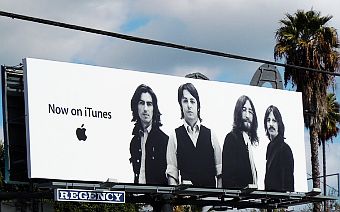
2010-2011: Billboard ads and building broadsides announcing availability of Beatles music on iTunes ran in major cities, this one along Sunset Blvd, Los Angeles, CA, November 2010.
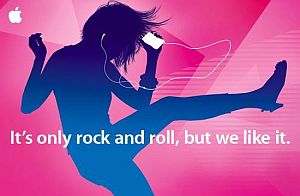
iPod silhouettes advertising helped establish Apple as a major player & trend setter in the digital music industry.
Apple also continued to experiment with new music features such as iTunes LP. Inspired by the 1970’s-style album covers, iTunes LP offered some musical “extras” to iTunes customers, providing album liner notes, lyrics, artwork, and exclusive photos and video.
And it also appeared likely there would be new arrangements to come from Apple in terms of music storage with what is called the iCloud.
The Silhouette Sell
Looking back on Apple’s business in the 2001-2010 period, it is clear that the iPod digital music player and the iTunes digital music store helped change the music industry and music culture the world over. And for Apple, its move into the music business – essentially, a completely new business direction – turned out to be more of an economic mainstay than its founding computer business.The iPod silhouettes ad campaign appears to have played a very central role in sending Apple rocketing into the big business pantheon. As for the advertising, it appears the iPod/iTunes silhouettes campaign – and its progeny – played a very central role in sending Apple rocketing into the big business pantheon. For it was that campaign’s imagery and social messaging that were readily absorbed by consumers and the culture in quite dramatic ways, helping increase sales initially of Mac computers and iPods, and later, many, many more iPods and lots of iTunes digital music. What first appeared as a modicum of iPod sales in the 2002-2004 period soon became more tsunami-like in the 2005-2010 period. iPods sold generally below 1 million units per year during 2002-2004. But between 2005 and 2011, Apple was selling 20 million or more iPods a year, and during the peak years from 2007 through 2010, annual sales of iPods ran at 50 million or more each year. Likewise, Apple’s stock value soared: in March 2003 it was $7 per share. By July 2008 it was $180 per share. Between 2005 and 2011, Apple sold 20 million or more iPods a year, peaking during 2007 – 2010, when it sold 50 million or more each year. During that 2003-2008 period, Apple’s share value increased a spectacular 2,500 percent, making Apple stockholders very happy indeed. There is no doubt that the iPod became the main driver in Apple’s phenomenal success during that period, providing the swelling coffers that enabled the company to continue doing great things through 2011. And while there were numerous factors involved in that successful business run, built upon great feats of engineering and design with hundreds of people playing key roles, it is clear that the advertising and marketing campaign conveyed a certain something about Apple products and Apple style – call it “coolness,” “hipness,” “joie de vie,” or whatever – that gave those products and the company a winning edge in both the marketplace and popular culture. And for that, iPod’s dancing silhouettes of the 2003-2008 period will surely remain distinguished stars in the annals of advertising for some time to come. They are no doubt dancing still; out there somewhere in the musical ether grooving to their favorite tunes.
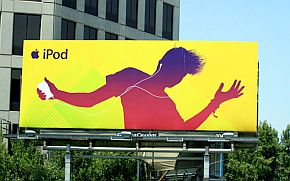
Apple iPod billboard ad in evolving silhouette style.
See also at this website, “Apple Rising, 1976-1985,” on Apple’s founding and early history with Steve Jobs and Steve Wozniak, covering the early computer biz, early Apple advertising, etc., up through Jobs being fired from his own company.
For other stories on music and/or technology, please see the category navigation bar at the top left corner of this page.
Thanks for visiting — and if you like what you find here, please make a donation to help support the research and writing at this website. Thank you. – Jack Doyle.
|
Please Support Thank You |
____________________________________
Date Posted: 9 December 2011
Last Update: 31 August 2023
Comments to: jackdoyle47@gmail.com
Article Citation:
Jack Doyle, “The iPod Silhouettes: 2000-2011,”
PopHistoryDig.com, December 9, 2011.
____________________________________
Books at Amazon.com…
Sources, Links & Additional Information
 May 2003: Steve Jobs on Fortune magazine cover with rocker Sheryl Crow, in prescient story that hints of bigger things to come with Apple & music. |
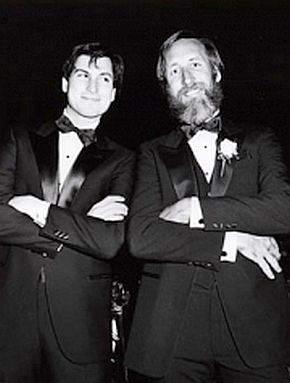 1984: Steve Jobs in earlier photo with friend & advertising guru Lee Clow, whose firm helped craft brilliant marketing campaigns for Apple, including the iPod silhouettes. |
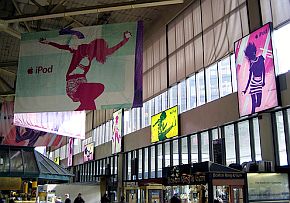 2007: iPod banners & posters, So. Station, Boston, MA. |
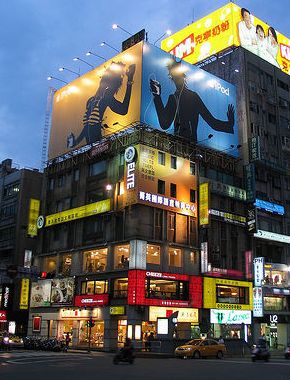 2005: iPod silhouette billboards, Taipei, Taiwan. |
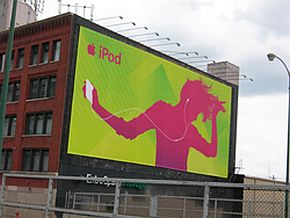 June 2008: iPod building broadside, Chicago, Ill. |
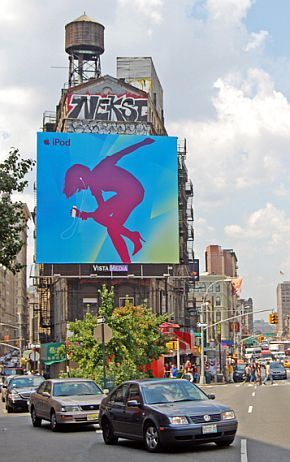 2008: iPod billboard, Chinatown, New York, NY. |
 iPod silhouettes are used widely on iTunes gift cards. |
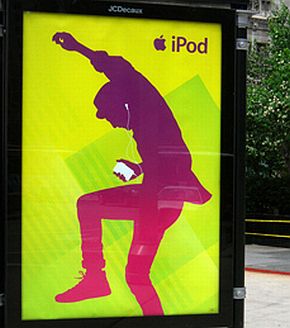 June 2008: iPod silhouette ad, Chicago bus kiosk. |
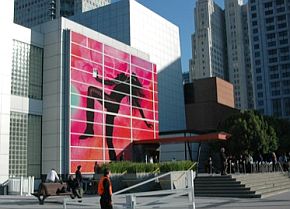 Sept 2006: Giant iPod silhouette display at the Yerba Buena Center for the Arts, San Francisco, CA. |
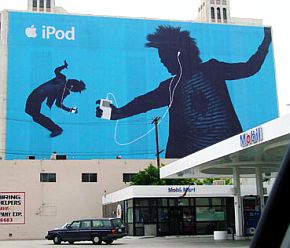 May 2004: Giant iPod silhouettes on building broadside, Santa Monica Blvd, Los Angeles. |
 2007: iPod silhouette-style ad on Seattle, WA bus. |
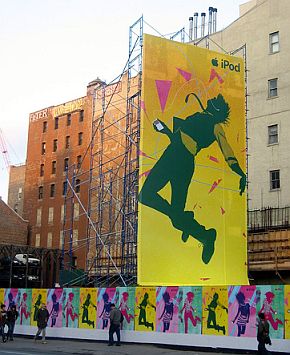 April 2007: Giant Apple iPod ad adorns construction scaffolding, Lafayette St., NY, NY. |
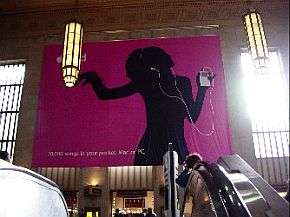 Nov 2003: Giant iPod silhouette wall posting at the 30th Street Station, Philadelphia, Pennsylvania. |
 iPod silhouette building ad using multi-colored style. |
 iPod ad draws notice against a gray Toronto skyline. |
Dennis Lloyd, “Instant Expert: A Brief History of iPod,” iLounge.com, Saturday, June 26, 2004.
“iPod,” Wikipedia.org.
“Apple Music Event 2001-The First Ever iPod Introduction,” (with Steve Jobs), You Tube.com.
Ian Fried, “Apple’s iPod Spurs Mixed Reactions,” CNet.com, October 23, 2001.
Matt Richtel, “Technology; Apple Intro- duces What It Calls an Easier to Use Portable Music Player,” New York Times, October 24, 2001.
“iPod Advertising,”Wikipedia.org.
Chris Taylor, “And The Pod Played On,” Time, Monday, November 12, 2001.
Josh Quittner with Rebecca Winters, “Apple’s New Core: How Steve Jobs Made a Sleek Machine That Could Be the Home-Digital Hub of the Future” Time, Monday, January 14, 2002.
Anita Hamilton, “The Digital Jukebox: Downloading Is Looking Up,” Time, Monday, May 12, 2003.
David Leonard, “Steve’s New Act: How He Plans to Save the Music Biz and Make Apple Rock,” Fortune (cover story), May 19, 2003.
Mae Anderson, “Print Silhouettes Come to Life in iPod TV,” AdWeek.com, Wed., October 8, 2003.
Wilson Rothman, “Sound Check: The New Napster,” Time, Monday, October 20, 2003.
“Apple- iTunes Music Event – ‘Hell Froze Over’ – 2003,” YouTube.com (Steve Jobs presentation on iPod, iPod silhouette ads, iTunes, and iTunes for Windows), Moscone West, San Francisco, CA, October 2003.
John Borland and Ina Fried, “Apple Launches iTunes for Windows,” CNet News, October 16, 2003.
“iTunes 4.1” (a review), EarthlingSoft.net, October 17, 2003.
“Apple Stepping Up with iTunes Internet Ads; Apple Pushing iTunes for Windows,” ChaosMint.com, Tuesday, October 21, 2003.
Chris Taylor, “Invention of the Year: iTunes Music Store,” Time, Sunday, November 16, 2003.
“iPod Ad Here, iPod Ad There, iPod Ads Are Everywhere!” (30th Street Station, Philadelphia), WYSZ.com, November 30, 2003.
Rob Walker, “The Guts of a New Machine,” New York Times Magazine, November 30, 2003.
“Ad Breakdown: Apple Emerges From the Pod,” BBC News, December 16, 2003.
“The Evolution of Apple Ads,” Web Designer Depot.com.
Theresa Howard, “Ads for iPods Offer Big Music Gift in Small Package; Big Part of Device’s Appeal Is ‘Cool’ Factor,” USA Today, January 5, 2004, p. B-8.
News, “Company 3’s Alex Brodie Rocks with Apple’s iPod,” DigitalProducer.com, Santa Monica, CA, January 5, 2004.
Kasper Jade, “Apple Heats Up World-Wide iPod Advertising,” AppleInsider.com, Tues., March 9, 2004.
Seth Stevenson, “You and Your Shadow; The iPod Ads Are Mesmerizing. But Does Your iPod Think It’s Better Than You?,” Slate.com, Tuesday, March 2, 2004.
Dennis Lloyd, “The Man Behind the iPod Ad Silhouettes,” iLounge.com, Tuesday, March 16, 2004.
Laurie J. Flynn, “Profit at Apple Almost Triples On a Sharp Rise in iPod Sales,” New York Times, April 15, 2004.
“Apple iPod ‘Silhouette’ Ad Campaign Takes Grand Kelly Award,” MacDaily News, Friday, June 11, 2004.
Steve Levy, “iPod Nation,” Newsweek, July 25, 2004.
Terril Yue Jones, “iPod’s ‘Halo Effect’ Lifts Apple Profit; The Company Credits the Music Player with Drawing New Customers to Apple Retail Stores and Boosting Sales of its Macs,” Los Angeles Times, October 14, 2004, p. C-1.
Apple, Inc., Apple Press Info,”Apple Introduces the U2 iPod; U2 and Apple Partnership Fuses Art, Technology & Commerce,”Apple.com, October 26, 2004.
Thomas Mucha, “Silhouettes and Synergy” (Business 2.0), CNN.com, Jan. 1, 2005.
Brent Schlender, “How Big Can Apple Get?,” Fortune, February 21, 2005.
Catharine P. Taylor, “Apple Unveils New Silhouette Ads,” AdWeek.com, October 13, 2005
Tariq, “Apple Pulls New Eminem Ad Spot,” AppleInsider.com, Thursday, October 13, 2005.
Mae Anderson, “TBWA\C\D’s ‘Silhouettes’ Alternative,” AdWeek.com, October 17, 2005
Leah Hoffmann, “Apple’s Iconic Ads,” Forbes.com, March 31, 2006.
“LAist Interview: Casey Leveque,” LAist .com, May 22, 2006.
“Dylan Gets ‘Modern,’ Stars in iPod Ad,” Spin.com, August 31, 2006.
Paul Boutin, “Live from the Steve Jobs Keynote — “It’s Showtime,” Engadget. com, September 12, 2006.
Matthew Creamer, “Bob Dylan Tops Music Chart Again–And Apple’s A Big Reason Why,” Advertising Age, October 8, 2006.
Philip Michaels, “Timeline: iPodding Through the Years: from Humble Beginnings Five Years Ago to Headliner Status Today,” Playlist Magazine, MacWorld.com, October 23, 2006.
Duncan, “Apple iPod Color Flathead Party with The Fratellis,” TheInspiration Room.com, January 12, 2007.
Duncan, “Apple iPod Goes Tropical on iTunes Island,” TheInspirationRoom.com, May 26, 2007.
Tom Hormby and Dan Knight, “A History of the iPod: 2000 to 2004,” LowEndMac .com, October 14, 2005, revised, September 2007.
Arnold Kim, “Mary J. Blige iPod + iTunes Ad,” MacRumors.com, Monday, November 19, 2007.
“Silhouette Campaign,” Marketing Cam- paign Case Studies, Thursday, February 28, 2008.
Project Team: Michael Shur and Tyler Reed, “iPod: The Marketing of An Idea,” University of St. Thomas – Marketing 300 / Dr. James Heyman. April 26, 2008.
Leander Kahney, Inside Steve’s Brain, New York: Portfolio/Penguin Group, 2008.
Cory Bohon, “New iPod Ad, Now Featuring Silhouettes,” TUAW.com, April 27, 2008.
Duncan, “Apple iPod Gamma to Shut Up and Let Me Go,” TheInspiration Room.com, April 29, 2008.
Charles Starrett, “Apple Airs New Coldplay iPod + iTunes TV Spot,” iLounge.com, Wednesday, May 21, 2008.
“iPod Campaign” AAPL Investors.net, ( iPod silhouette ad photos, Chicago, IL ), June 2008.
JR Ordonez, “The Music That Saved Apple: Comprehensive List of Songs from Ipod Commercials,” TouchTip.com, September 5th, 2008.
“The iPod and Advertising: A Case Study In It’s Evolution,” SlideShare.net, 2009.
Neil Hughes, “iTunes a Quarter of Music Sales; Apple a Third of Wi-fi Use,” AppleInsider.com, Tuesday, August 18, 2009
Saurabh Sharma, “Apple iPod Commu- nication Strategy,” Scribd.com, Roll No: 34PGDM: 2009-11.
Jack Doyle, “Apple, Rising, 1976-1985,” PopHistoryDig.com, May 10, 2010.
“The Best Songs Ever Used in iPod Commercials,” EdibleApple.com, Thurs., August 12, 2010.
Ian Paul, “Apple: The King of Digital Music,” PCWorld.com, September 3, 2010.
Lexie Brown “Is Advertising Art?,” September 5, 2010.
“The 10 Best Ads to Come Out of Steve Jobs’ Reign at Apple: As Legendary Marketer Steps Down, Ad Age and Creativity Pick Their Top Spots,” AdAge.com, August 24, 2011.
Sean Highkin, “Assessing the Influence of U2 and Those Silhouette Ads on the iPod’s Success,” SFWeekly.com, Thursday., August 25, 2011.
Andrew Hampp, “10 Songs Steve Jobs Made Famous: From the Black Eyed Peas to Chilly Gonzales, a Look Back at Silhouettes, Shuffles and iPads,” AdAge .com, August 26, 2011.
David Greenwald, “Steve Jobs & Apple: 10 Pitch-Perfect Music Ads (Video),” Holly- wood Reporter.com, October 6, 2011.
Jennifer Bergen”Ten Years of Apple iPod Commercials,” PCmag.com, October 25, 2011.
Andy Cush, “10 Years of iPod Commercials Reveal Apple’s Trajectory: From Techie to Sassy,” Evolver.fm, October 28, 2011
Andy Cush, “10 Years of iPod Ads: From Techie to Sassy,” Wired.com, October 29, 2011
Walter Isaacson, Steve Jobs, New York: Simon & Schuster, November 2011, 630 pp.
“iPod Poster for Sale, Blue – U.S. Edition, circa 2004,” Vintage & Modern Posters From Around the World, International Poster.com, viewed, December 7, 2011.
Justin D. Salsburey, “Semiotic Analysis of iPod Advertisements,” Sites.Google.com.
“Topics: Apple iPod Silhouette Commer- cials,” YouTube.com.
“iPod Advertisements” (photo gallery), Dipity.com.
“iTunes,” Wikipedia.org.
“iTunes Store,” Wikipedia.org.
“List of Music Used by Apple Inc.,” Wiki- pedia.org.
Eric Lewis, “Offical iPod Song Commercial List,” iLounge.com, March 30, 2007.
“Apple Commercial Music,” AAPL Investors .net.
“iPod Sales Per Quarter,” Wikipedia.org.
__________________
iPod T.V. Ads – Sample List
(debut, iPod vintage, ad type, song, artist)
2001, first iPod ad, “Take California,” Propellerheads (not a silhouette ad), You Tube.com.
2003, iPod+iTunes, Now for Windows: “Hey Mama,” Black Eyed Peas, YouTube .com.
2003, iPod 3G, “Rock Star (Jason Nevins Remix), N.E.R.D., YouTube.com.
2003/2004 iPod, “Are You Gonna Be My Girl?,” Jet, YouTube.com.
2004, iPod 4G, iPod + iTunes,”Channel Surfing” by Feature Cast, YouTube.com.
2004, iPod 4G, iPod + iTunes, “Walkie Talkie Man” by Stereogram, YouTube .com.
2004, iPod 4G, “Saturday Night” by Ozomatli, YouTube.com.
2004, iPod + iTunes, “Vertigo” by U2, You Tube.com (2 minute version).
2004, iPod + iTunes, “Vertigo” by U2, You Tube.com (30 second version).
2005, iPod 4G, “Technologic” by Daft Punk, YouTube.com.
2005, iPod 4G, “Ride” by The Vines, You Tube.com.
2005, iPod Shuffle 1G, “Jerk It Out” by The Caesars, YouTube.com.
2005, iPod 4G, “Feel Good Inc” by Gorillaz, YouTube.com.
2005, iPod + iTunes, “Lose Yourself” by Eminem, YouTube.com.
2005, “Sparks,” Wynton Marsalis, You Tube .com.
2006, iPod 5G, iPod+iTunes, “LoveTrain,” Wolfmother, YouTube.com.
2006, iPod & iTunes, “Someday Baby,” Modern Times album, Bob Dylan, You Tube.com.
2007, iPod + iTunes, “Mi Swing Es Tropical,” Quantic and Nickodemus, You Tube.com.
2007, iPod, “Flathead,” The Fratellis, You Tube .com.
2007, iPod + iTunes, “Dance Tonight,” Paul McCartney, YouTube.com.
2008, iPod + iTunes, “Shut Up and Let Me Go,” The Ting Tings, YouTube.com.
2008, iTunes, “Viva la Vida,” Coldplay (sil-houetted artists w/ white wires), YouTube.com.
____________________________


